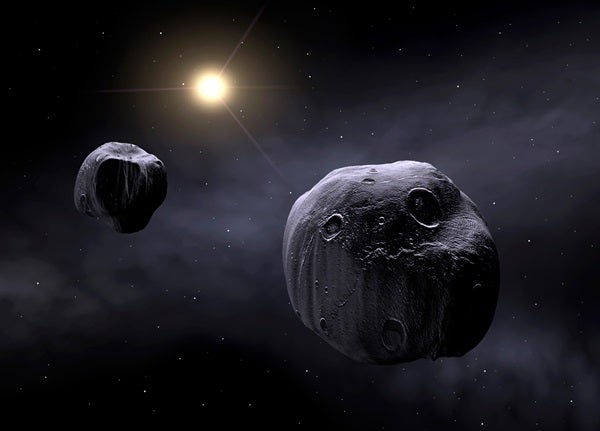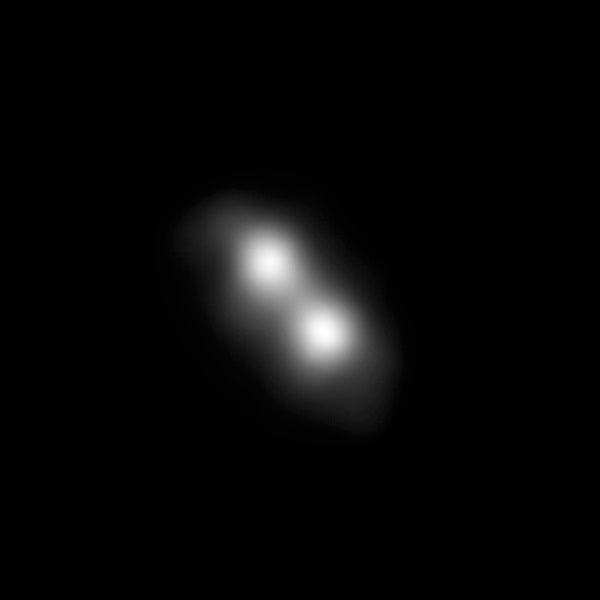Imagine two Earths side by side, whirling around a small gap between them. Too implausible, even for a sci-fi movie, right? You just never see twins in space, at least not among planets, moons, comets, or asteroids.
Thus, when Robert Luther discovered asteroid number 90 in 1866, neither he nor anyone else suspected Antiope (pronounced an-TIE-uh-pee) was anything but just another faint 8th-magnitude dot flying along a typical path in the main asteroid belt between Mars and Jupiter. Decades after astronomers found the first asteroid on the opening day of the 19th century, the world now resigned itself to countless rocky chunks turning up with tedious regularity. New ones were discovered yearly, duly named, numbered, and forgotten.

Bringing the universe to your door. We’re excited to announce Astronomy magazine’s new Space and Beyond subscription box – a quarterly adventure, curated with an astronomy-themed collection in every box. Learn More >>.
As the asteroid count grew from dozens to hundreds to thousands, astronomers found this growing catalog possessed distinct differences. In Antiope’s region, asteroids are always dark, displaying the spectral signature of carbonaceous material. These asteroids are also renowned for their skimpy, low-density construction (1.3 g/cm³), just barely heftier than water ice, but with a pitch-black surface that reflects a mere 6 percent of incoming sunlight. They are all darker than the lunar “seas” on our Moon and much blacker than asphalt.
Definitely odd, yet 90 Antiope still never warranted a headline until the summer of 2000, when a group of astronomers discovered that it isn’t a single object, but two. Antiope’s components are virtually the same size: two nearly spherical globes 55 and 52 miles (88 and 84 kilometers, respectively) across, symmetrically separated by about 53 miles (85km). Nothing like this twin asteroid exists anywhere else in the known universe. Because astronomers have no precedent for this, they will eventually let the slightly larger of the two keep the name Antiope and call its neighbor a moon, giving it its own name and dressing the pair in matching outfits.
The twins share a circular orbit in which both whirl around the middle of the empty space between them every 16.5 hours. Fortunately, as the whirling duo orbit the Sun in a 5.6-year elliptical path, there comes a time when the plane of their mutual orbit perfectly aligns edgewise to us. Then, for half a year, each takes turns partially eclipsing the other every eight hours. The resulting light curve reveals details about their shapes. Thus, we now know that the twins’ deviation from being perfect spheres, although slight, is the exact shape expected of two closely orbiting balls of liquid!
This means that tidal and gravitational interactions have caused both of these bodies to flow into a “Roche lobe,” a state of gravitational equilibrium that produces two slightly teardrop-shaped globes whose tips aim at the other. That the material of each member so perfectly oozed into its theoretical Roche lobe is no small puzzle because these bodies are neither gaseous nor liquid. For solid objects, friction should prevent them from assuming this shape, just as big earthly piles of gravel or powder are never pulled by gravity into flat pools, but resist flowing due to the frictional resistance between the particles.
A much bigger puzzle is figuring out how such a twin-body situation came about in the first place. One of the two bears a 40-mile-wide (64km) impact crater, suggesting that 90 Antiope was originally a single body struck violently and torn in two. Unfortunately, such a scenario would never result in an almost even distribution of mass in which both bodies had circular orbits. Mathematicians can make the story work if a nearby planet’s gravity helped sculpt the eventual configuration, but Antiope never ventures near any planet.
Another thought is that one of the bodies captured the other when it passed too closely. But this could never result in the current configuration either.
The most intriguing and workable solution is also the strangest. What if Antiope was once a single body that suffered a “grazing collision” with another asteroid? If the visitor hit the asteroid obliquely and abruptly sped up its rotation, the original Antiope, composed as it is of lightweight, barely-stuck-together bits of stone, could have broken apart due to centrifugal force. This scenario could produce matching components made of the same materials, along with a fast orbit around a common center of gravity.
Researchers continue to watch the Antiope twins. Where else can they ever observe such perfect fast-paced choreography by twin balls of utter blackness?











